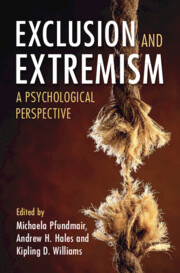Book contents
- Exclusion and Extremism
- Exclusion and Extremism
- Copyright page
- Dedication
- Contents
- Contributors
- Introduction
- Part I The Link between Exclusion and Extremism
- Part II Drivers of the Exclusion–Extremism Link
- Part III Topics Related to the Exclusion–Extremism Link
- 11 Rejection and Serious Aggression
- 12 Chronic Social Exclusion, Radicalization, and Extremism
- 13 Connecting Conspiracy Beliefs and Experiences of Social Exclusion
- Index
- References
12 - Chronic Social Exclusion, Radicalization, and Extremism
from Part III - Topics Related to the Exclusion–Extremism Link
Published online by Cambridge University Press: 16 May 2024
- Exclusion and Extremism
- Exclusion and Extremism
- Copyright page
- Dedication
- Contents
- Contributors
- Introduction
- Part I The Link between Exclusion and Extremism
- Part II Drivers of the Exclusion–Extremism Link
- Part III Topics Related to the Exclusion–Extremism Link
- 11 Rejection and Serious Aggression
- 12 Chronic Social Exclusion, Radicalization, and Extremism
- 13 Connecting Conspiracy Beliefs and Experiences of Social Exclusion
- Index
- References
Summary
The theoretical models propose that chronic social exclusion inevitably leads individuals into a state of psychological resignation and behavioral withdrawal. After reviewing the literature addressing chronic exclusion among general and marginalized populations, we propose that the chronic exclusion–resignation link might not be inevitable and that chronically excluded individuals remain sensitive to novel social affiliations. From here, we discuss how chronic exclusion and the resignation stage can sensitize individuals to the early stages of the radicalization process. We propose that the indomitable need for affiliation may drive chronically excluded individuals toward social resurrection when supported by prosocial sources of reconnection. However, without such avenues, radicalization may become an appealing path for reaffiliation, leading to extremist groups. This chapter elucidates the complex interplay between chronic exclusion, resignation, and radicalization, and it might inform the development of targeted strategies fostering social reintegration and preventing the allure of extremist ideologies among chronically excluded individuals.
Keywords
- Type
- Chapter
- Information
- Exclusion and ExtremismA Psychological Perspective, pp. 263 - 286Publisher: Cambridge University PressPrint publication year: 2024
References
- 1
- Cited by

